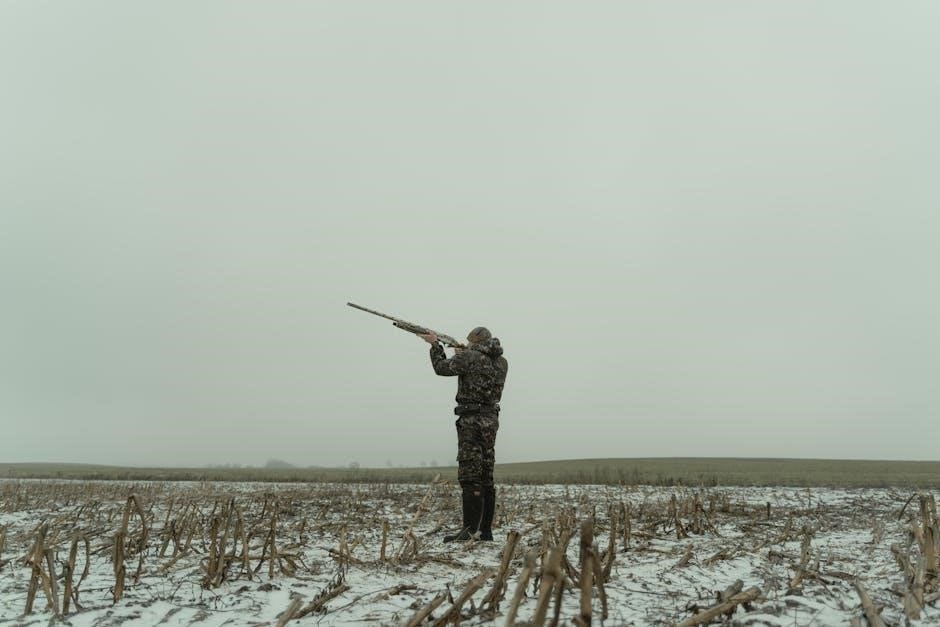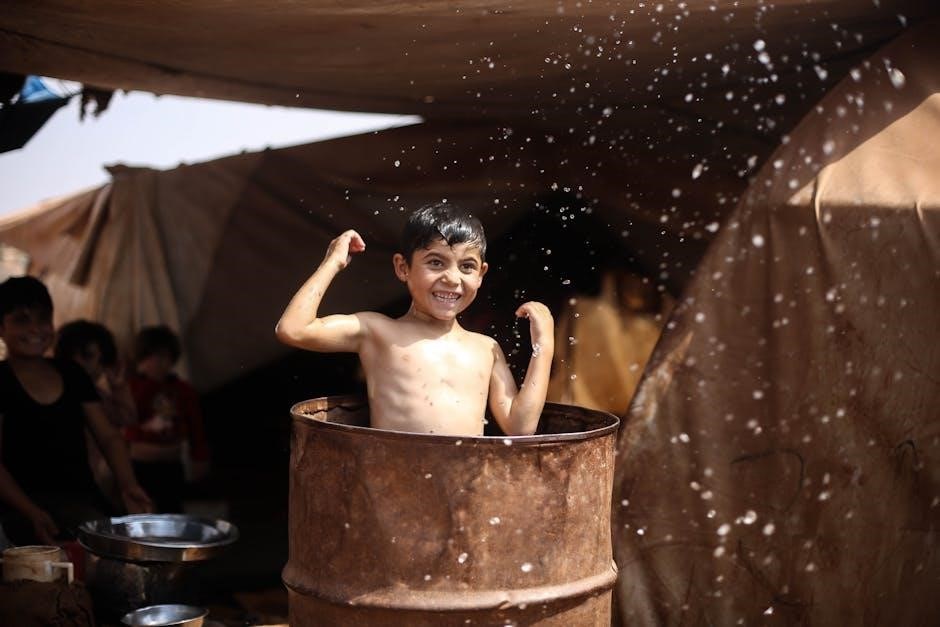Survival guides provide essential skills and strategies for navigating challenging environments, ensuring safety, and maintaining well-being in diverse situations, from wilderness adventures to urban emergencies.
1.1 Importance of Survival Skills
Survival skills are crucial for navigating life-threatening situations, ensuring safety, and maintaining well-being in challenging environments. These skills empower individuals to respond effectively to emergencies, whether in the wilderness or urban settings. By mastering survival techniques, one gains the ability to secure basic necessities like food, water, and shelter, which are essential for sustaining life. Additionally, survival skills foster mental resilience, enabling individuals to remain calm and make rational decisions under stress. They also promote self-reliance, reducing dependence on external aid. In urban scenarios, these skills help individuals navigate dangers such as natural disasters or civil unrest. Ultimately, survival skills are a vital tool for preparedness, enabling individuals to adapt to unforeseen circumstances and enhance their chances of survival. They are not just about physical endurance but also about mental fortitude and resourcefulness in the face of adversity.
1.2 Brief History of Survival Techniques
Survival techniques have evolved over millennia, rooted in humanity’s need to adapt to harsh environments. Early humans developed tools like stone knives and fire-starting methods to secure food and shelter. Indigenous communities refined these practices, creating sophisticated strategies for hunting, foraging, and navigation. In ancient civilizations, survival skills were often tied to military tactics and exploration. The medieval period saw advancements in shelter construction and water purification. Modern survival techniques incorporate both traditional methods and contemporary innovations, such as multi-tools and GPS navigation. The 20th century popularized survival guides through literature and media, making these skills accessible to the general public. Today, survival techniques are applied in wilderness adventures, disaster preparedness, and urban safety, reflecting a blend of historical wisdom and modern ingenuity. This evolution underscores the enduring relevance of survival skills in ensuring human resilience.

Essential Survival Tools
Survival tools are crucial for staying safe and self-sufficient in emergencies. A reliable multi-tool, navigational aids, and water purification devices are indispensable for any survival situation, ensuring preparedness and adaptability.**
2.1 Must-Have Items for a Survival Kit
A well-prepared survival kit is essential for emergencies, ensuring you have the tools to stay safe and self-sufficient. Key items include:
- Water and food supplies: At least 3 days’ worth of non-perishable food and 1 gallon of water per person daily.
- Shelter materials: A lightweight tent, tarp, or emergency blanket to protect from the elements.
- Navigation tools: A compass, map, and GPS device to help you find your way.
- A multi-tool or knife: For cutting, opening, and repairing items.
- First aid kit: Including bandages, antiseptics, pain relievers, and any personal medications.
- Fire-starting equipment: Matches, a lighter, or a firesteel to build warmth and cook food.
- Communication devices: A phone, radio, or whistle to call for help.
- Extra gear: Flashlight, batteries, and a change of clothes.
These items ensure you can meet basic needs, signal for help, and adapt to challenges in any survival situation.
2.2 How to Choose the Right Multi-Tool
Selecting the right multi-tool is crucial for survival situations, as it provides versatility and functionality in a compact design. When choosing a multi-tool, consider its durability, weight, and the variety of functions it offers. A good multi-tool should include essential features like a knife, pliers, screwdriver, and can opener. Additionally, look for models with a sturdy build, rust-resistant materials, and ergonomic design for comfortable use. Portability is also key—opt for one that is easy to carry on a belt or in a pocket. Some multi-tools come with additional features like wire cutters or saws, which can be invaluable in specific scenarios. Lastly, consider the warranty and reputation of the manufacturer to ensure reliability. By evaluating these factors, you can choose a multi-tool that meets your survival needs effectively;
2.3 The Role of Navigation Instruments
Navigation instruments are indispensable for survival, enabling individuals to determine their location, track movements, and find their way safely. Tools like compasses remain fundamental, providing directional guidance even without GPS. Maps are equally vital, offering a visual representation of terrain and landmarks. GPS devices enhance accuracy but rely on battery life and satellite connectivity. For long-term reliability, a compass paired with a map is often the most trustworthy combination. Additionally, learning to use natural navigation cues, such as the sun’s position or constellations, can serve as a backup. Modern tools like GPS watches and smartphone apps offer convenience but should be supplemented with traditional methods. Proper training in using these instruments is essential to ensure they function effectively in high-stress survival situations. By mastering navigation instruments, individuals can maintain orientation and make informed decisions to stay safe. These tools are critical for both wilderness and urban environments, where getting lost can quickly escalate into a crisis.
Wilderness Survival
Wilderness survival involves mastering skills like finding food, building shelters, and starting fires without matches, ensuring safety and sustenance in remote, natural environments.
3.1 Finding Food and Water
Finding food and water is crucial for survival in the wilderness. Start by identifying edible plants, fishing, or hunting small animals. Always purify water from streams or ponds using methods like boiling, sand filtration, or solar disinfection. Collecting dew or rainwater can also be effective. When foraging, avoid poisonous plants and rely on tools like knives or traps. Store food safely to prevent attracting wildlife. Proper hydration is essential, so carry a reusable container and know how to locate water sources. Mental resilience plays a key role in maintaining the energy to search for sustenance. Remember, survival depends on balancing food and water intake with energy expenditure. Always prioritize safety and efficiency in your search for resources.
3.2 Building Shelters
Building a shelter is a critical survival skill to protect yourself from harsh weather and wildlife. Start by gathering materials like branches, leaves, and pine needles. Use a debris hut or lean-to structure for simplicity. Ensure the shelter is waterproof by layering leaves or grasses. A tarp or plastic sheet can enhance durability if available. Always choose a location with good drainage and protection from wind; Avoid areas prone to flooding or insect nests. Use a knife or trowel to dig a foundation if needed. Keep the shelter small to conserve energy and retain body heat. Add bedding like grasses or moss for comfort. Remember, the goal is to create a safe, dry space to rest and recover. Proper shelter construction can significantly improve your chances of survival in the wilderness.
3.3 Starting a Fire Without Matches
Fire is a lifesaver in survival situations, providing warmth, light, and a way to cook food. Without matches, you can use friction methods like the bow drill or hand drill; Gather dry tinder, kindling, and larger logs. Prepare the area by clearing leaves and creating a fire pit. Use a flint and steel or a ferro rod to spark onto tinder. Solar fire starting with a magnifying glass or clear plastic bottle is also effective. Always ensure materials are dry, as moisture will hinder ignition. Practice these techniques to build confidence and efficiency. Fire starting is a skill that requires patience and persistence but is essential for survival in the wild. Keep extra tinder dry by storing it in a waterproof container. A well-built fire can boost morale and provide critical support in emergencies.
3.4 Navigation Techniques
Navigation is a critical survival skill, ensuring you can find your way safely. Use natural signs like the sun’s position, stars, or moss growth on trees to determine direction. Carry a compass and map, and learn to read them. GPS devices are helpful but rely on batteries, so know how to use them wisely. Create landmarks or markers to avoid walking in circles. Follow streams or rivers, as they often lead to civilization. Always carry extra batteries and backup tools.Practice triangulation using visible points to pinpoint your location. Stay calm and methodical to conserve energy and avoid panic. Navigation requires observation, preparation, and patience, but mastery can be lifesaving in the wilderness. Always plan your route and share it with others before venturing out. Adaptability and awareness are key to staying on course in unfamiliar terrain.
3.5 Signaling for Help
Signaling for help is crucial in survival situations to alert rescuers. Use reflective surfaces like mirrors or shiny objects to catch sunlight and direct it toward potential rescuers. Create large, visible signals on the ground, such as arranging rocks, branches, or clothing to form an “X” or “HELP.” Fires can also serve as effective signals, especially at night or in foggy conditions. Smoke signals during the day can be seen from a distance. If near a road or trail, place obstacles or markers to draw attention. Use whistles to create loud, repeating sounds, as they carry farther than shouts. Stay visible by wearing bright clothing or attaching reflective materials to your shelter. Always conserve energy while signaling, balancing effort with visibility. The key is to make yourself as noticeable as possible while waiting for rescue. Preparation and creativity in signaling can significantly improve your chances of being found quickly.
3.6 Managing Wildlife Encounters
Encounters with wildlife require calmness and awareness to ensure safety. Keep a safe distance from animals, as sudden movements can provoke them. Make noise while hiking to avoid surprising wildlife, such as bears or snakes. Carry bear spray or pepper spray as a deterrent. If confronted, stand tall and maintain eye contact without staring aggressively. Never run, as this can trigger a chase response. Instead, back away slowly and give the animal a clear path to leave. For smaller wildlife, secure food and trash to avoid attracting pests. Use protective gear like mosquito nets or insect repellent in areas with biting insects. Stay alert in environments where dangerous animals are common. Knowledge of local wildlife and their behaviors is key to avoiding conflicts. Always prioritize caution and preparedness when in areas where wildlife encounters are possible. Stay calm, and remember that most animals prefer to avoid humans. Preparation is your best defense.

Urban Survival
Urban survival involves preparedness for emergencies, self-defense, and navigating city-specific dangers. It requires situational awareness, knowledge of local risks, and having a plan for unexpected situations, ensuring safety and adaptability in dynamic environments.
4.1 Emergency Preparedness in Cities
Emergency preparedness in cities is crucial for handling unexpected events like natural disasters, power outages, or civil unrest. A well-thought-out plan ensures safety and resilience. Start by identifying potential risks specific to your urban environment, such as earthquakes or floods. Create a survival kit with essentials like water, non-perishable food, a first-aid kit, and a multi-tool. Stay informed about emergency procedures and evacuation routes. Familiarize yourself with local shelters and safe zones. Additionally, consider alternative lighting sources, such as flashlights, and communication tools, like a battery-powered radio. Knowing your community’s resources, such as local support groups or emergency services, can also be lifesaving. Regular drills and updates to your plan will keep you prepared. Urban survival requires a balance of awareness, planning, and adaptability to overcome challenges effectively.
4;2 Self-Defense Techniques
Self-defense techniques are vital for urban survival, enabling individuals to protect themselves in dangerous situations. Awareness is key—stay alert to surroundings and avoid risky areas when possible. Basic techniques include maintaining a strong stance, using verbal de-escalation, and targeting vulnerable areas if physical confrontation is unavoidable. Tools like pepper spray or a personal alarm can also deter attackers. Mental preparedness is equally important, as confidence and quick decision-making can prevent escalation. Additionally, consider enrolling in self-defense courses, such as Krav Maga or Brazilian Jiu-Jitsu, to build practical skills. Always be mindful of legal and ethical considerations when using force. By combining awareness, physical skills, and mental resilience, self-defense techniques enhance urban survival capabilities and foster a safer environment.
4.3 Navigating Urban Dangers
Navigating urban dangers requires a blend of awareness, preparedness, and strategic thinking. Stay informed about local crime trends and avoid poorly lit or isolated areas, especially at night. Trust your instincts and keep valuables secure to minimize theft risks. Familiarize yourself with emergency services and landmarks to ensure quick access in crises. Utilize technology, such as GPS apps, to stay oriented but avoid distractions while walking. Building a network of trusted contacts and knowing safe gathering points can enhance safety. Avoid engaging with suspicious individuals and maintain a confident demeanor to deter potential threats. Regularly update your emergency plan and practice situational awareness to adapt to changing urban environments. By combining these strategies, urban dangers can be effectively managed, ensuring personal safety and confidence in navigating city life.

Disaster Preparedness
Disaster preparedness involves creating emergency plans, stocking essential supplies, securing safe shelters, and staying informed about potential risks. It also requires community cooperation and regular drills.
5.1 Earthquake Survival Tips
Earthquake survival requires quick thinking and preparedness. Start by securing heavy furniture and objects to prevent them from falling. Create an emergency plan with your family, identifying safe spots like under sturdy tables or against interior walls. During an earthquake, drop to the ground, take cover, and hold on to the shelter. Avoid windows and exterior walls. Stay calm and follow evacuation routes if necessary. After the quake, check for injuries, provide first aid, and be cautious of aftershocks. Keep a disaster supply kit with essentials like water, food, and a flashlight. Practice drills regularly to ensure everyone knows what to do. By staying informed and prepared, you can significantly increase your chances of staying safe during and after an earthquake.
5.2 Flood Survival Strategies
Flood survival requires preparation and quick action. Stay informed about weather conditions and sign up for emergency alerts. Create a flood emergency kit with essentials like water, non-perishable food, and a first aid kit. Know your evacuation routes and practice them with your family. During a flood, avoid walking or driving through flooded areas, as even shallow water can be dangerous. Move to higher ground immediately if instructed to evacuate. Turn off utilities like electricity and gas before leaving. After the flood, avoid contaminated water and wear protective gear when cleaning. Check for structural damage before reentering your home. By staying prepared and following these strategies, you can minimize risks and stay safe during and after a flood.
5.3 Tornado Safety Measures
Tornado safety begins with preparedness. Create a tornado emergency plan with your family, identifying safe areas in your home, such as basements or storm cellars. If no underground shelter is available, go to an interior room or hallway on the lowest floor, away from windows. Practice drills to ensure everyone knows the safest route and assembly point. Stay informed with a weather radio or smartphone app for real-time alerts. During a tornado, seek shelter immediately. If driving, leave your vehicle and find a nearby building or lie flat in a ditch. After the tornado, be cautious of debris and fallen power lines. Avoid damaged buildings and follow evacuation instructions from authorities. Regularly update your emergency kit with supplies like flashlights, batteries, and a first aid kit. Preparation and awareness are key to surviving a tornado safely.

Mental and Physical Health
Maintaining mental resilience and physical stamina is crucial for survival. Practices like mindfulness, staying hydrated, and managing stress ensure overall well-being in challenging situations, enhancing endurance and focus.
6.1 Maintaining Mental Resilience
Mental resilience is a cornerstone of survival, enabling individuals to stay focused and calm under pressure. Techniques such as positive thinking, mindfulness, and stress management help maintain emotional balance. Practicing deep breathing exercises and visualization can reduce anxiety, while staying connected with others fosters a sense of community and support. Setting realistic goals and celebrating small achievements boosts morale and motivation. Additionally, staying informed about your situation without becoming overwhelmed by negativity is key. Mental resilience also involves accepting challenges as opportunities for growth, fostering adaptability and determination. By cultivating these traits, individuals can navigate survival situations with confidence and clarity, ensuring they remain mentally strong and capable of overcoming adversity. Resilience is not just a skill but a mindset that can be developed and strengthened over time.
6.2 First Aid for Common Injuries
First aid is crucial for managing injuries in survival situations, preventing minor issues from escalating into serious health threats. Assessing the injury is the first step, ensuring the surrounding area is safe. For wounds, stop bleeding by applying direct pressure with a clean cloth or bandage. Elevate the injured limb if possible to reduce swelling. Burns should be cooled with clean water, not ice, to avoid further damage. Fractures require immobilization using splints or makeshift supports to prevent movement. Infections can be prevented by cleaning wounds with antiseptic solutions or alcohol. Pain management can be achieved with over-the-counter medications if available. Knowing these techniques ensures injuries are treated effectively, reducing the risk of complications and promoting recovery. Proper first aid skills are essential for maintaining health and stability in challenging environments.
6.3 Managing Stress in Survival Situations
Survival situations often trigger stress, which can impair decision-making and reduce focus. Recognizing early signs of stress, such as rapid breathing or heightened anxiety, is crucial. Techniques like deep breathing exercises can help calm the mind and stabilize emotions. Maintaining a clear mindset allows for better problem-solving and resource allocation. Establishing a routine, even in chaotic environments, provides a sense of control and normalcy. Positive visualization and goal-setting can boost morale and motivation. Teamwork, when possible, distributes responsibilities and reduces individual burden. Prioritizing tasks and breaking them into manageable steps prevents overwhelm. Adequate rest and hydration are essential to maintain physical and mental resilience. Managing stress effectively ensures that individuals remain capable of responding to challenges without emotional or psychological breakdown. These strategies are vital for enduring survival scenarios with composure and clarity.